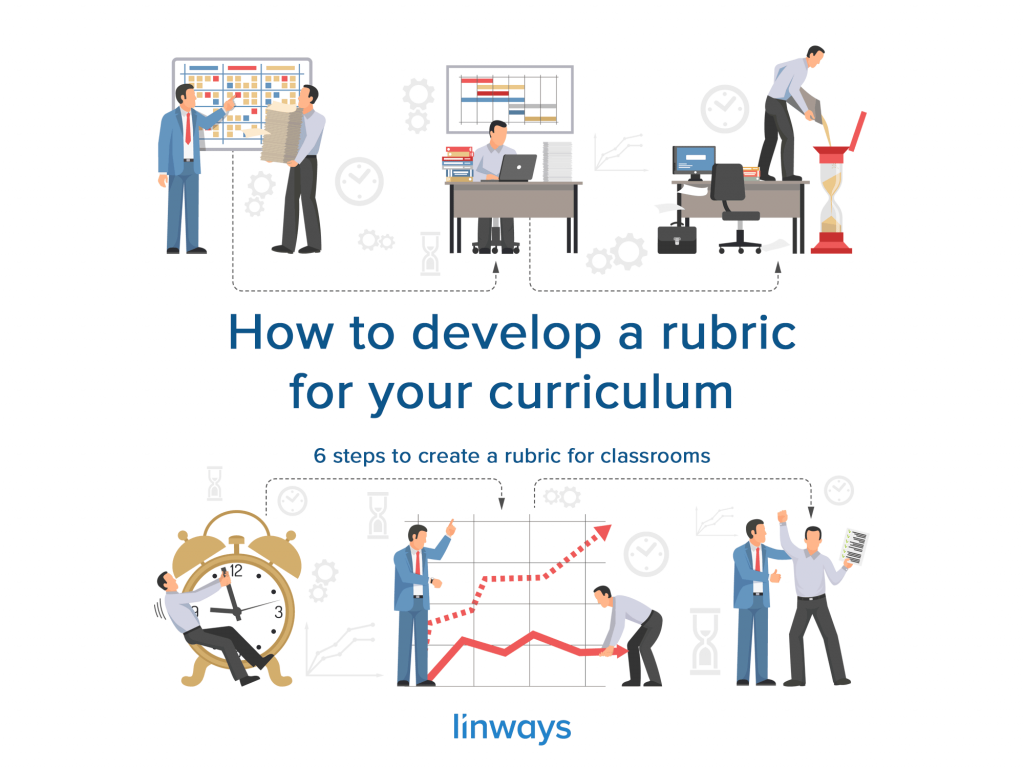6 steps to create a rubric for classrooms in the context of higher education

We discussed about the basics, definitions, and various types of rubrics in our previous blog; “An Introduction to Rubrics for Higher Education”. As we saw in that blog, a Rubric is a set of criteria/guidelines to assess and evaluate learning. So how do we create a rubric for classrooms.
How to develop a rubric for your classroom
There are multiple steps involved, and creating an effective, efficient, rubric is not an easy task. We have narrowed the process down to these 6 steps to help you through the process.
Step 1: Define outcomes and goals for the rubric
Step 2: Choose the rubric type
Step 3: Define the assessment criteria
Step 4: Define the performance levels
Step 5: Write performance descriptions for each level of rubric
Step 6: Revise – reinvent – repeat
Now let’s look at each of those one-by-one.
Defining the outcomes and goals for the rubric.
The first step is to figure out your learning outcomes and goals for the program/course. Building a rubric can only assist you if you have a clear hold on what you are going to measure, and why. So write down the learning outcomes early, before building the rubric itself. These questions may help you better define your purpose and goals:
- What are the learning outcomes?
- Will you use rubric to assign a grade?
- How do you want to assess performance?; grades, marks, normalisation,
- What standards must the students hit in order to achieve acceptable or exceptional performance?
- Do I want to give one final grade on the project or a cluster of smaller grades based on several criteria?
- How will students demonstrate they’ve learned these outcomes?
Once you have answered these questions, it’s time to move on to the next step:
Choosing the Rubric type.
As we saw in the previous blog, there are essentially three types of Rubric models present. Holistic, Analytic, and Checklist. There are also other models evolved from these basic models too. But most of them are way too similar to spent time discussing about it.
So from the insights you’ve collected from the first step, decide which type of Rubric model might be the best fit for your classroom. You don’t want to put too much pressure on this step because you already have the necessary data to make the decision. You can also change the model later if you want. Now to the next step, i.e.,
Defining the assessment criteria.
This is an important step in the development of a rubric. Your rubric is as good as the assessment criteria it uses. So take enough time, and write down every bit of detail you need for reaching the most comprehensive set of criteria that you will be using to measure with the rubric.
Based on the learning outcomes, define a key set of knowledge and skills you need to assess. List out how you want your students to display what they’ve learned, and you’ve arrived at the criteria! If you prefer, here’s a list of questions to help your get started.
- What do you want students to learn from the task?
- How will students demonstrate that they have learned?
- What knowledge, skills, and behaviors are required for the task?
Combining the answers to these three questions will get you to the criteria for the rubric. When you are ready with the assessment criteria, it’s time to move on to defining the performance levels.
Define the performance levels.
The performance levels are broadly defined as to the extent to which you want to score the assessment outcomes. This can be in grades, marks, or any other methods that you see fit. Now unless you are using the checklist method, which contains just the two rating levels, you shall create and assign various performance levels to each of your criteria. Deciding how many levels you’d want is more of a judgement call, but we do recommend that you base your decision on the learning outcomes, assessment criteria, and the purpose of building the rubric.
One thing you should remember while defining performance levels is to keep the ratio between performance levels constant. (The difference between a “1” and “2” should be the same as the difference between “4” and “5.” Using different ratios for different levels might cause confusion among students and create imbalances in your assessment results.)
Once you have your criteria and performance levels, write performance descriptions for each level of the rubric.
Write performance descriptions for each level of the rubric.
This is a very important step in the process. In this step, you’ll need to write specific statements that maps performance levels with each criterion.
The descriptions should explain what criteria are met, and how well. It should also provide insights into why the assessment levels are where they are. For instance, a statement like “Communicated using excellent language & displayed knowledge transfer capabilities” helps define to what extend the criteria was achieved, and why the student wasn’t awarded a higher grade.
If you’ve made it this far, we’ve got a solution that will help you simplify and streamline these processes with ease. Linways Academic Management System, is a platform that helps teachers, management, and the students to manage academics and simplify mundane daily tasks.
Linways helps teachers to build rubrics that are valuable in improving quality in teaching-learning. With Linways AMS to support the academics, all the assessments can be easily mapped with outcomes so that their achievement can be easily calculated with minimal manual labour. Teacher can also decide whether to share assessments with their students or not, thereby improving student engagement and participation.
Linways AMS also supports rubrics-based mark entry which takes the workload off the shoulders of the faculty. The data related to the learning outcomes, curriculum, and students will be readily available on the platform. So creating custom reports, rubrics-based teaching methods, and detailed evaluation reports to collect meaningful insights is easy and error-free with Linways.
Also published on Medium.




